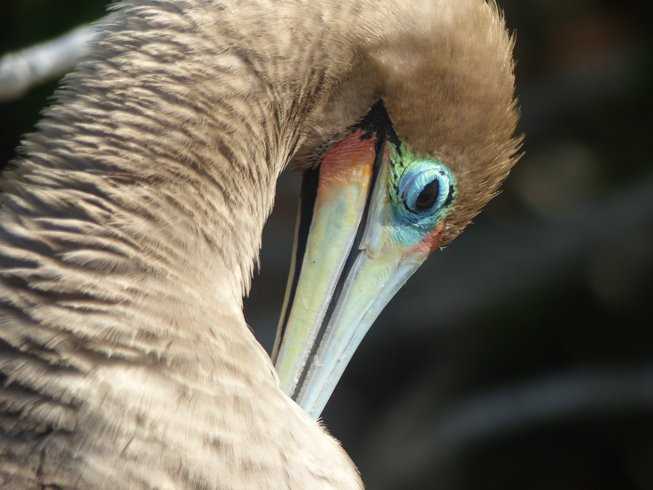There is already a slight change to be felt in the air. The end of April is leading us into May, a transition month that takes us from the warm, wet season into the cool, dry season. Possibly my favorite time of year is now.
An early start got us ashore onto a rubble-strewn coralline beach. We are in the northern hemisphere today, the island bathed in warmer waters year-round, so coral growth is bit more common than in the southern or western islands of Galapagos. Over the eons, fragments of coral, parrotfish sand and shell fragments have been washed ashore on the only available beach in the interior of the crater.
It is not an explosive crater that has formed Darwin Bay, but a collapse of gigantic proportions, millennia ago, that dropped the top layers of volcanic material into the empty magmatic chamber down below. The top edges of the caldera end abruptly in a direct fall into water that is hundreds of feet deep. Outside Genovesa, the ocean floor lies at around 100 feet, within anchoring range for most ships, but inside is a different story.
But we are here to see the wildlife, which on this island means sea birds galore. The ones that capture our attention are the noisy ones. Red-footed boobies have a rough-sounding cracking call; the great frigatebird males are displaying and calling out with their warbling, echoing love song; the red inflated gular pouch accents the sound. The vegetation is still green, and with red, black and glossy green feathers, these large birds are show-stealers.
But the ocean was calling as well: snorkeling! Despite the greener water conditions which limit visibility (typical for Genovesa) we saw the largest of the Galapagos parrotfish, the bumphead parrotfish, my favorite the sunset wrasse, and the black and yellow Moorish Idols in pairs lit up the depths. What we were all hoping for finally showed up: hammerhead sharks. These elegant animals swam below us, minding their own business, making their circuits of the bay as they have done forever.
The afternoon was spent visiting the far side of the bay, a visitor site known as Prince Philip’s Steps. A clamber up a fissure, aided by a few concrete steps and wooden handrail added by the park service years ago, brought us to the top. For me – this precise place is a world apart. The largest of the three booby species found in Galapagos, the Nazca booby has taken over the area. These grand white and black sea birds dominate the ground under bushes, below Palo Santo trees. They have favorite perching rocks near their nest sites. Guano rings delineate each nest, so circles were distributed along both sides of the trail.
By sunset we were all home; for “home” describes the National Geographic Islander now that everyone has been living here on board for the last seven days. We know our spaces, our fellow inhabitants, and now our guests are familiar with the larger outside world of Galapagos as well.
Our “Lindblad family” has just expanded!







